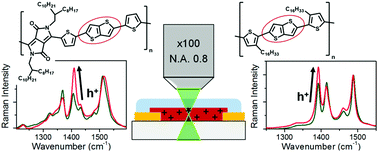Raman spectroscopy and microscopy of electrochemically and chemically doped high-mobility semiconducting polymers†
Abstract
The polaronic nature of two high-mobility hole-conducting polymers (PBTTT and DPPT-TT) is investigated by Raman spectroscopy and density functional theory (DFT) calculations. Chemical and electrochemical hole doping of these polymers leads to characteristic changes in the intensity ratios of the Raman active C![[double bond, length as m-dash]](https://www.rsc.org/images/entities/char_e001.gif) C stretching modes but no significant frequency shifts. The data indicate a localization of positive polarons on the electron-rich thienothiophene cores that are present in both polymers. DFT calculations show that the Raman intensity ratio variations are most likely caused by the local electric field that originates from negatively charged dopant molecules or electrolyte anions and the positive polaron on the polymer chain. The characteristic changes in the Raman mode intensity ratios with the degree of doping enable in situ mapping of charge carrier concentration in the channel of electrolyte-gated polymer transistors with high spatial resolution.
C stretching modes but no significant frequency shifts. The data indicate a localization of positive polarons on the electron-rich thienothiophene cores that are present in both polymers. DFT calculations show that the Raman intensity ratio variations are most likely caused by the local electric field that originates from negatively charged dopant molecules or electrolyte anions and the positive polaron on the polymer chain. The characteristic changes in the Raman mode intensity ratios with the degree of doping enable in situ mapping of charge carrier concentration in the channel of electrolyte-gated polymer transistors with high spatial resolution.

- This article is part of the themed collection: Celebrating Excellence in Research: Women of Materials Science


 Please wait while we load your content...
Please wait while we load your content...